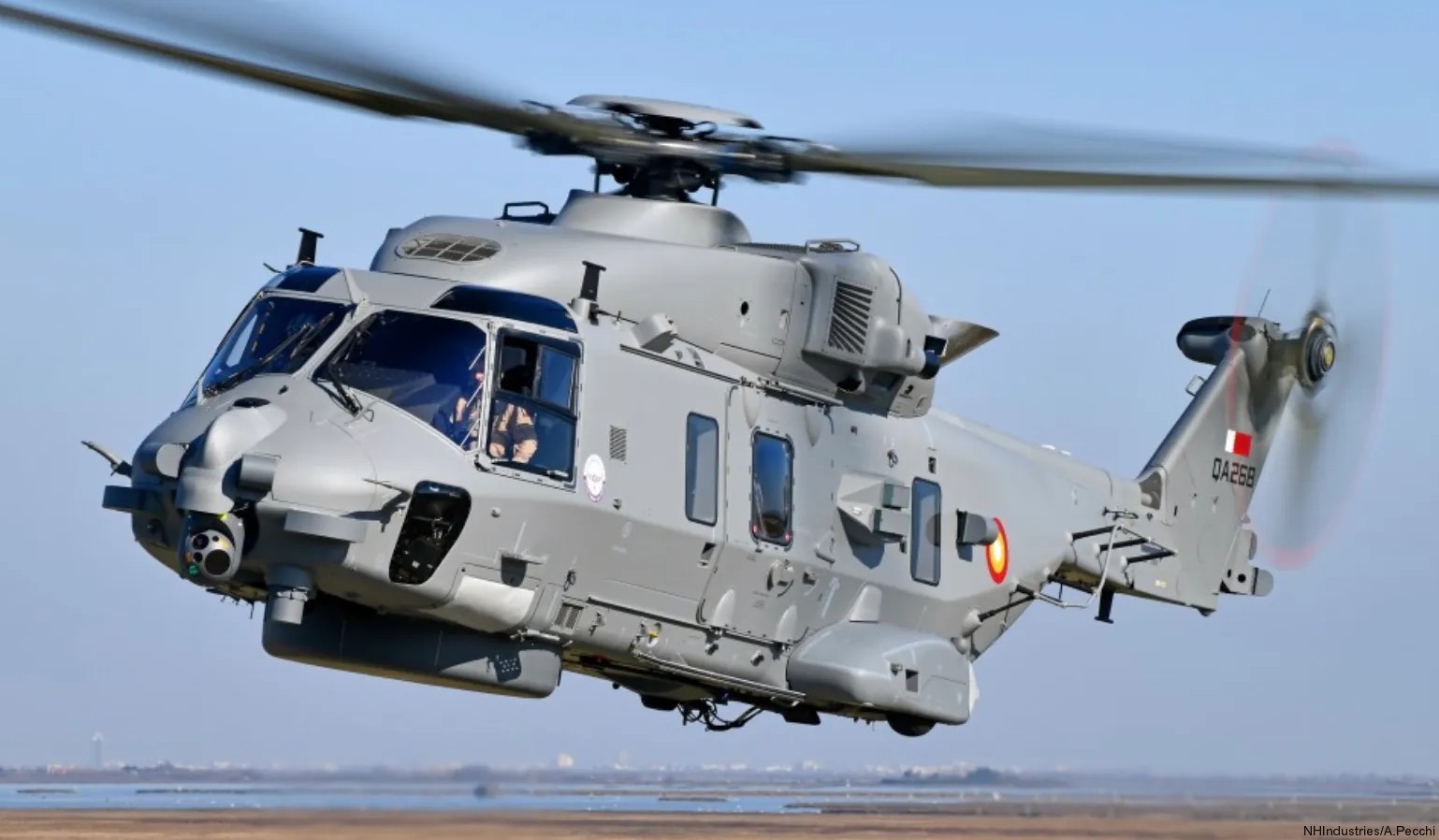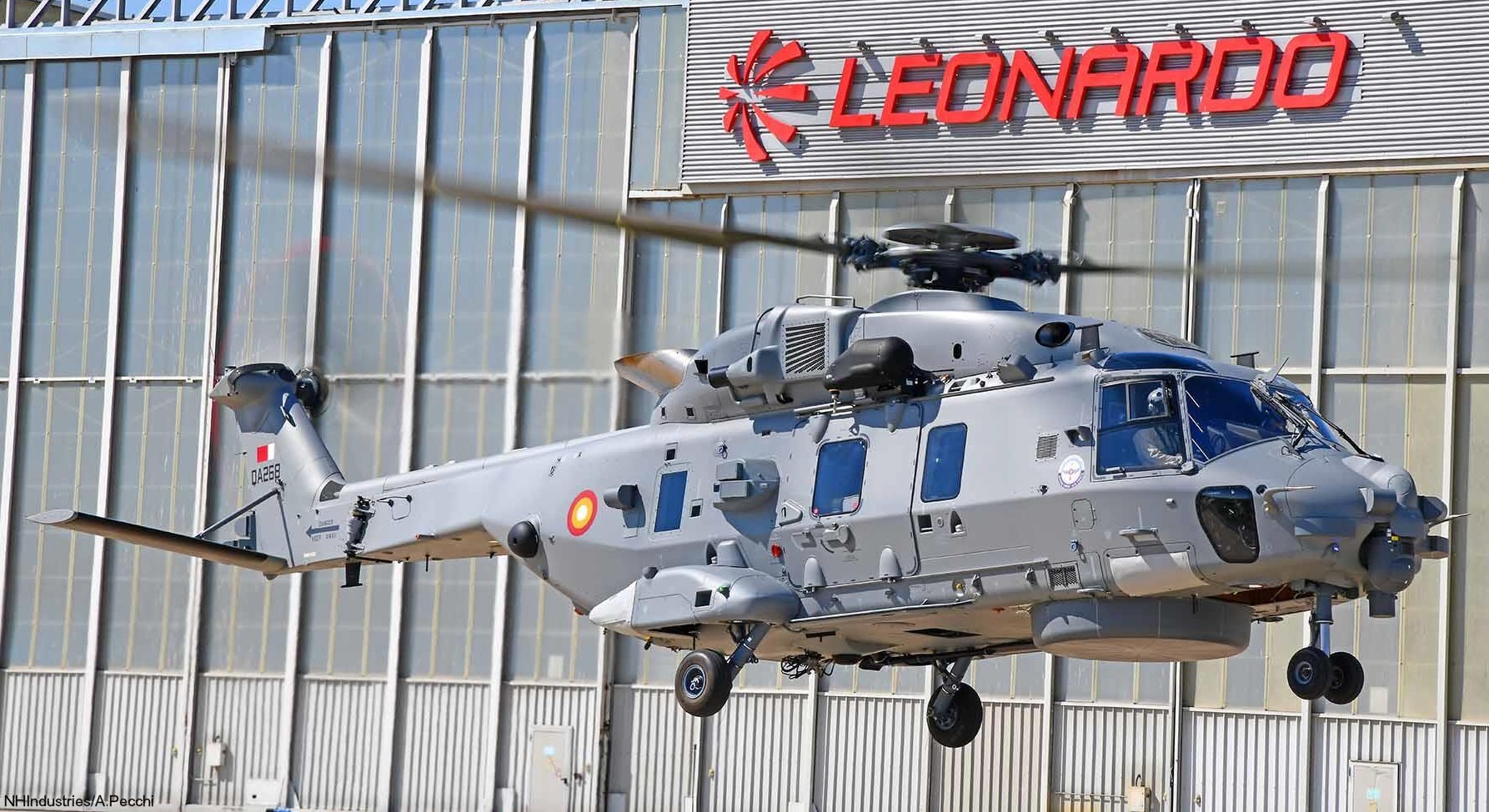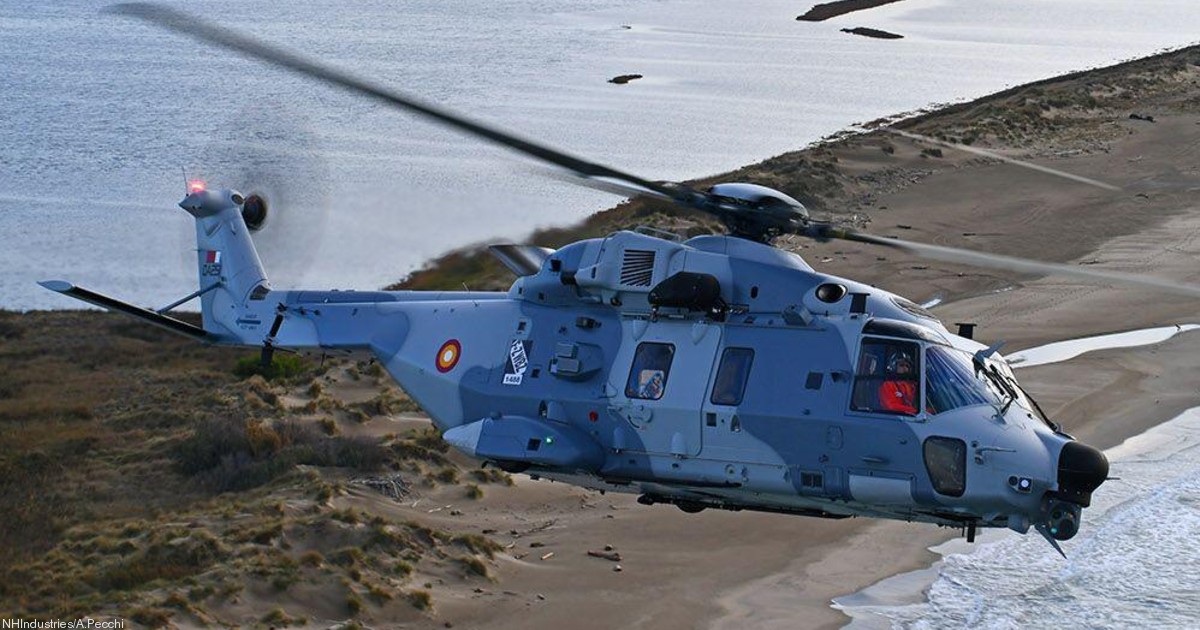 |
|
|
HOME
|
US Navy -
ships
|
US Navy - air
units
|
USMC - air
units
|
International
Navies
|
Weapon Systems
|
Special Reports |
|
|
State of Qatar - Qatari Emiri Air Force NHIndustries NH-90 NFH+TTH |
|
 |
|
| 05/24 | |
| Units: | |
|
|
|
The NHIndustries NH90 is a medium-sized,
twin-engine, multi-role military helicopter. It was developed in
response to NATO requirements for a battlefield helicopter which
would also be capable of being operated in naval environments. The
NH90 was developed and is manufactured by NHIndustries, a
collaborative company, which is owned by Airbus Helicopters,
Leonardo (formerly AgustaWestland) and Fokker Aerostructures. The
first prototype conducted its maiden flight in December 1995; the
type first entered operational service in 2007. The NH90 has the distinction of being the first production helicopter to feature entirely fly by wire flight controls. There are two main variants, the Tactical Transport Helicopter (TTH) for army use and the navalised NATO Frigate Helicopter (NFH); each customer typically has various alterations and customisations made to their own NH90 fleets, such as different weapons, sensors and cabin arrangements, to meet their own specific requirements. In early service, the NH90 has suffered several teething issues, which has in turn delayed active deployment of the type by some operators. The NH90 was designed to fulfill a NATO staff requirement for a multi-role, medium-sized military helicopter for both land and maritime operations. According to Flight International, the NH90 has the distinction of being the first helicopter in the world to be developed in line with NATO requirements. As such, the design of the NH90 meets with multiple national and international standards, including military airworthiness processes in Germany, France, Italy, and the Netherlands; conformance with FAR 29 and MIL-STDS design standards, as well as DEF-STN 00-970 icing conditions performance and electro-magnetic compatibility. It is produced in two principal variants, the battlefield Tactical Transport Helicopter (TTH) and the maritime NATO Frigate Helicopter (NFH). One key innovation of the rotorcraft is the four-channel fly-by-wire control system employed; the NH90 is the first helicopter in the world to be equipped with full fly-by-wire flight controls. A four-axis autopilot is also integrated with the fly-by-wire system, as are mission and navigation systems to enable greater autonomy during operations and to reduce pilot workload. The flight envelope of the NH90 is capable of all-weather day-and-night operations, ship-borne operations during high sea states, across a temperature range from −40 °C to +50 °C, and up to a maximum altitude of 20,000 feet. Power is provided by a pair of turboshaft engines, dependent on customer selection, the NH90 is either fitted with Rolls-Royce Turbomeca RTM322 or General Electric T700E powerplants; exhaust gases from the engines are filtered through an infrared suppression system for decreased sensory visibility. According to Airbus Helicopters, the NH90 possesses the lowest radar signature in its class, principally due to its diamond-shaped composite fuselage. The NH90 featured an advanced composite airframe, designed for ballistic tolerance, a high level of crashworthiness, lower weight, and 30 per cent greater endurance than a metallic counterpart. The four main rotor blades are also composed of composite materials, increasing fatigue strength and lifespan while providing for greater damage tolerance. The unobstructed main cabin area is entered either by large sliding doors on either side of the fuselage or via a rear ramp, the cabin is designed to accommodate modular equipment packages to enable the rotorcraft to be rapidly reconfigured, providing for operational flexibility. In a troop-transport capacity, the cabin can accommodate up to 20 fully equipped soldiers, or up to 12 stretchers in a medical evacuation role, some light vehicles may also be transported; the main cabin is equipped with environmental control systems and sound proofing measures to improve passenger conditions. The NH90 can be equipped with various mission-specific systems, including modular armor plating around the cabin area for undertaking high-risk missions and an ice protection system for operations within cold climates. It can also make use of the In-Hover Flight Refuelling System (HIFR) as well as additional internal and external fuel tanks to conduct extended range missions. Other equipment includes a wire strike protection system, rappelling system, hoist, cargo hook, search light and various seating options, including crashworthy foldable seats. For performing maritime operations, such tasked NH90s are typically equipped with the Harpoon deck-locking system, automatic main rotor blade and tail folding mechanisms, and other deck handling systems to conduct all-weather ship-borne operations; it is also typically outfitted with dipping sonar and sonobuoy processing equipment. The NH90 features a range of customizable avionics systems, dependent on customer selection and purpose. On some models, French firm Thales Group provides various parts of the avionics, such as the glass cockpit, full-colour multifunction displays, tactical mission and encrypted communication systems, the TopOwl helmet-mounted sight/display, IFF and autonomous navigation systems, and the electrical power generation system. Other systems include a forward looking infrared (FLIR), weather radar, digital map generation system, enhanced ground proximity warning system, personal locator system, and VHF/UHF/HF tactical radios. In 2015, the NH90 became the first helicopter to receive an laser-based airborne collision avoidance system. Onboard mission systems feature a dual-redundant databus, are compliant with MIL-STD 1553, and are comprehensively managed via sensor fusion functionality. Customer demand for future avionics improvements such as new data links and communication systems, as well as additional electro-optical sensors, have been anticipated by the manufacturer. In 2014, Qatar announced that it was set to spend $2.76 billion on procuring NH90s to modernizing its military helicopter fleet. A contract valued at 3 billion euros was signed at the Dimdex defence exhibition on 14 March 2018, which finalised the purchase of 28 NH90s, comprising 16 NH90s for tactical transport and 12 NH90s for naval purposes. On 20 August 2018, Leonardo announced the contract with Qatar was made effective for a total sum of US$3.7 billion, covering the agreed upon number of NH90s, with an option with six more of each type. On 23 December 2020, the first flights for Qatari-bound NH90s were being conducted for general evaluation. The first two NH90 for Qatar were handed over in March 2022. - - - - - Airbus helicopters press release: Doha, 14 March 2018 Qatar has signed a contract for the purchase of 28 NH90 military helicopters, during DIMDEX, Qatar’s biennial defence exhibition. The agreement, which includes 16 NH90s in tactical transport (TTH) configuration and 12 NH90s in naval (NFH) configuration, will support the country’s plan to modernise their military helicopter fleet. As part of the plan, Qatar will receive 16 H125 light single-engine helicopters in training configuration for operation by the Qatar Armed Forces Air Academy. “We are honoured to support the Qatar Armed Forces through this strategic partnership”, said Ben Bridge, Executive Vice President Global Business at Airbus Helicopters. “The NH90 is a modern and combat-proven asset that will meet Qatar’s demanding operational requirements for decades to come, both in troop transport and naval missions. Our partnership on the new training academy will also strengthen the relationship between our countries by enabling the exchange of expertise and know-how in helicopter operations”, he added. Leonardo will act as prime contractor for the programme management with the end customer and Airbus will be responsible for the final assembly and delivery of 16 NH90 TTH aircraft from its facility in Marignane, France while Leonardo will be responsible for final assembly and delivery of the 12 NH90 NFH helicopters from its Venice - Tessera facility in Northern Italy. The NH90 is well suited for operations in the most demanding conditions and has been combat-proven in many theatres of operation worldwide. This contract for 28 helicopters brings the total order book to 543 aircraft. To date, 350 aircraft have been delivered to 20 customers in 13 countries and have accumulated around 170,000 flight hours. The twin-engine, medium-size NH90 helicopter program is managed by the consortium NHIndustries, a company owned by Airbus Helicopters (62.5%), Leonardo (32%), and Fokker (5.5%). - - - - - Characteristics: Crew: 3-4 Capacity: 20 seated troops; or 12 medevac stretchers; or 2 NATO pallets; or 4200 kg (9260 lb) external slung load Length: 16.13 m (52 ft 11 in) Rotor diameter: 16.30 m (53 ft 6 in) Height: 5.23 m (17 ft 2 in) Empty weight: 6400 kg (14100 lb) Useful load: 4200 kg (9260 lb) Max. takeoff weight: 10600 kg (23370 lb) Powerplant: 2 x Rolls-Royce Turbomeca RTM322-01/9 turboshaft, 1662 kW (2230 shp) or 2 x General Electric T700-T6E turboshaft, 1577 kW (2115 shp) each Maximum speed: 300 km/h (162 knots, 186 mph) Range: 800 km (497 mi) TTH / 1000 km (621 mi) NFH Service ceiling: 6000 m (20000 ft) Rate of climb: 8 m/s (1574 ft/m) Armament: 12.7 mm (caliber .50) door gun / Torpedoes source: wikipedia / Leonardo / Airbus |
|
| images | |
 NFH configuration  TTH configuration |
|
|
|
seaforces.org
|
Qatari
Navy start page
| |